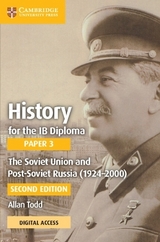
History for the IB Diploma Paper 3 The Soviet Union and Post-Soviet Russia (1924–2000)
Cambridge University Press (Verlag)
978-1-316-50369-0 (ISBN)
- Titel erscheint in neuer Auflage
- Artikel merken
Chapter 1. Introduction; Chapter 2. Stalin's rise to power, 1924-29: 2.1. Overview; 2.2. What was Stalin's position before 1924?; 2.3. How did Stalin win the struggle for power after 1924?; 2.4. Why was Stalin able to defeat his rivals?; Chapter 3. Stalin's revolution, 1929-41: 3.1. What were Stalin's main economic policies?; 3.2. How successful were Stalin's economic policies?; 3.3. What did Stalin do to consolidate his power?; 3.4. How did Stalin's foreign policy try to achieve security for the Soviet Union in the 1930s?; Chapter 4. Stalin and the Soviet Union, 1941-53: 4.1. How did the Great Patriotic War, 1941–45, affect the Soviet Union?; 4.2. What were Stalin's main political and economic policies,1945-53?; 4.3. How did the emerging Cold War affect Stalin's foreign policy after 1945?; Chapter 5. Khrushchev and de-Stalinisation, 1953-64: 5.1. What were Khrushchev's main political reforms?; 5.2. How did Khrushchev try to reform the Soviet economy?; 5.3. What were the main features of Khrushchev's foreign policy?; Chapter 6. The Brezhnev era: Stagnation and Drift, 1964-85: 6.1. What were the main political developments in the USSR 1964–85?; 6.2. What were the main features of the Soviet economy 1964–85?; 6.3. How did Soviet foreign policy develop during this period?; Chapter 7. Gorbachev and the years of reform, 1985-89: 7.1. What were Gorbachev's main economic policies 1985–89?; 7.2. How did Gorbachev try to democratise the Soviet political system?; 7.3. What were the main consequences of Gorbachev's foreign policy during the 1980s?; Chapter 8. The collapse of the Soviet Union, 1990-91: 8.1. What happened with Gorbachev's economic policies 1990–91?; 8.2. What happened with Gorbachev's attempts to democratise the Soviet political system?; 8.3. Why did the Soviet Union collapse in 1991?; Chapter 9. Yeltsin and post-Soviet Russia, 1992-2000: 9.1. What were the main aspects of Yeltsin's rule in Russia 1992–96?; 9.2. How did Yeltsin maintain his rule from 1996-2000?; 9.3. Has the 'spectre of communism' been laid to rest?; Chapter 10. Exam Practice; Further Reading; Index.
| Erscheinungsdatum | 27.04.2016 |
|---|---|
| Reihe/Serie | IB Diploma |
| Zusatzinfo | Worked examples or Exercises |
| Verlagsort | Cambridge |
| Sprache | englisch |
| Maße | 152 x 229 mm |
| Gewicht | 490 g |
| Themenwelt | Schulbuch / Wörterbuch |
| Geschichte ► Allgemeine Geschichte ► Neuzeit (bis 1918) | |
| Geisteswissenschaften ► Geschichte ► Regional- / Ländergeschichte | |
| ISBN-10 | 1-316-50369-0 / 1316503690 |
| ISBN-13 | 978-1-316-50369-0 / 9781316503690 |
| Zustand | Neuware |
| Haben Sie eine Frage zum Produkt? |
aus dem Bereich



